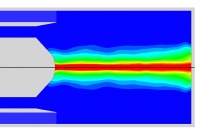Flow Z-Pinch for Fusion

Technology Description:
The University of Washington (UW), along with its partner Lawrence Livermore National Laboratory, will work to mitigate instabilities in the plasma, and thus provide more time to heat and compress it while minimizing energy loss. The team will use the Z-Pinch approach for simultaneously heating, confining, and compressing plasma by applying an intense, pulsed electrical current which generates a magnetic field. While the simplicity of the Z-Pinch is attractive, it has been plagued by plasma instabilities. UW will investigate Z-pinch fusion using sheared-flow stabilized plasmas, meaning that adjacent layers of the plasma move parallel to each other at different speeds. These sheared axial flows have been shown to stabilize Z-pinch instabilities, and the team will investigate whether this will hold true under more extreme conditions using experimental and computational studies. If successful, UW’s design would simplify the engineering required for an eventual reactor through its reduced number of components and efficiency. In addition, the design’s avoidance of single-use components would enable fusion research to progress faster through more rapid experimentation.
Potential Impact:
If successful, UW’s work will validate a new type of Z-pinch approach, enabling a low-cost, rapid development path towards economical fusion power.
Security:
UW’s innovation could accelerate the development of cost-effective fusion reactors, which could provide a nearly limitless supply of domestic power and eliminate dependence on foreign sources of energy.
Environment:
Fusion reactors offer nearly zero emissions and produce manageable waste products. If widely adopted, they could significantly reduce or nearly eliminate carbon emissions from the electricity generation sector.
Economy:
UW’s approach, if viable, could enable a low-cost path to fusion, reducing research costs to develop economical reactors.
Contact
ARPA-E Program Director:
Dr. Scott Hsu
Project Contact:
Prof. Uri Shumlak
Press and General Inquiries Email:
ARPA-E-Comms@hq.doe.gov
Project Contact Email:
shumlak@uw.edu
Partners
Lawrence Livermore National Laboratory
Related Projects
Release Date:
08/24/2014
